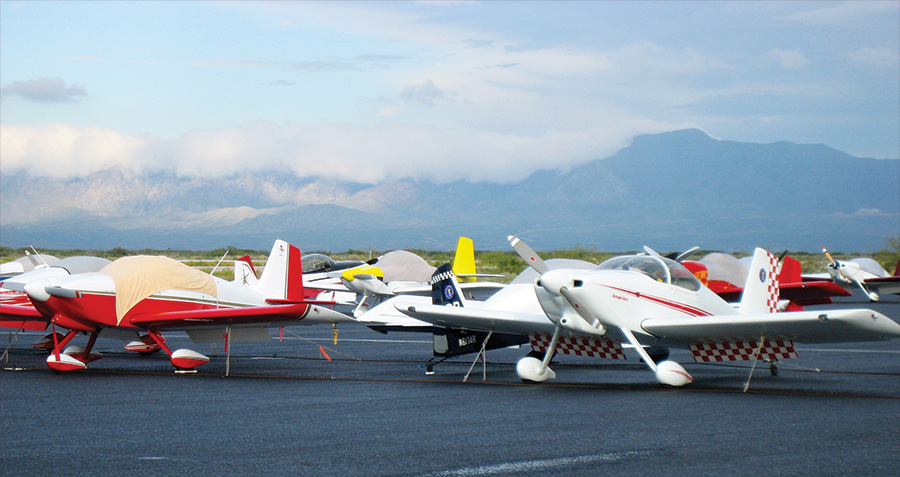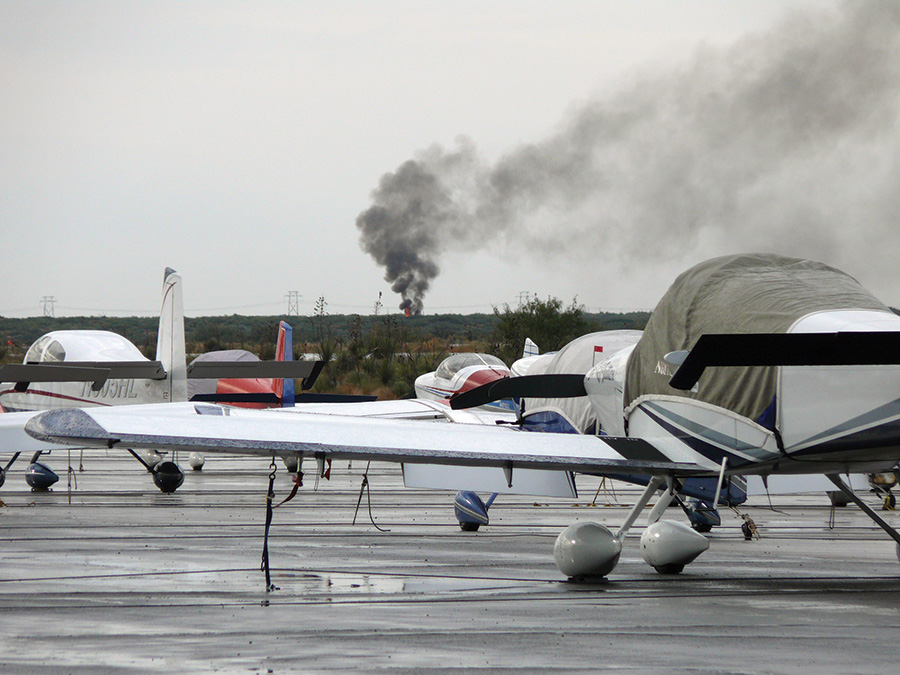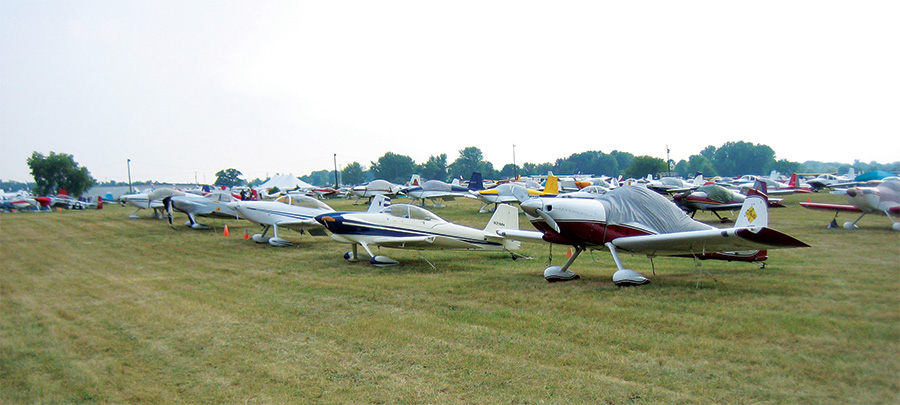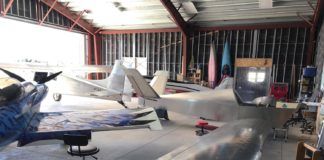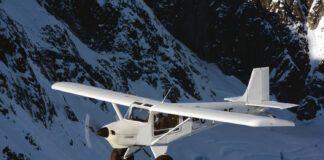We all go to fly-ins. Some of us attend nearly every one within a decent range of our home airport, while others get to only a few each year. Here in the Midwest, the fly-in season runs from late May until mid-to-late October, after which the weather isn’t dependable enough to assume good VFR weather over a hundred or so mile radius from about any airport. So, our fly-ins get to be crammed together during that six-month period. Those in the warmer climes see things a bit more spread out.
Fly-ins come in all shapes and sizes. Some are very informal gatherings of just a few pilots who decide to go someplace for a picnic, or to visit an airport restaurant, just as an excuse to fly to another airport, rather than take a local flight. Others may occur at an airport, with advanced planning and advertisements posted at fields within a reasonable radius of the sponsoring airport. The EAA holds some regional fly-ins, like the Mid-Eastern Regional Fly-In (MERFI) at Urbana, Ohio each year. AOPA has discontinued its national convention and fly-in, in favor of regional events, culminating with the last one of the season held at its headquarters in Frederick, Maryland. And, of course, the granddaddy of them all, Oshkosh, occurs in late July or early August each year.
Each type of fly-in poses some risk to participants and whenever there is risk, unfortunately, there is potential liability to go along with it. We all know that at Oshkosh some accident will happen every year, often, but not always, with serious injury or a fatality as a result. But the large fly-in isn’t the only place where risk attends, and it isn’t the only place where someone may be liable for whatever happens, and that someone isn’t just the pilot involved in the accident.
Flour Bombing
Allow me to tell a war story or two. One of my first aviation accident defense cases as a pup lawyer in the late 1970s resulted from a tragedy that happened at a fly-in. Back in those days, many fly-ins would sponsor what was called a bomb drop contest, when airplanes would fly low and slow over the runway, and someone in the airplane would toss out a sack of flour, hoping to hit or come close to a target painted on the runway. Sounds like fun and it was—as long as you were competent at slow flight at a very low altitude, usually less than 100 feet agl. Unfortunately, like in many other endeavors, one’s own perception of his flying skills may not match reality.
A county airport was holding a fly-in, and the events of the day included a bomb drop contest. The accident airplane was a Taylorcraft BC-12. The passenger was tasked with opening the door on the right side of the airplane at the appointed moment, and he tossed out the bag of flour. The pilot added full power to pull up away from the “bomb run,” pulled the nose up too steeply and at about 300 agl the T-Craft stalled and immediately spun, with the predictable result. The pilot survived, but with fairly serious injuries necessitating a long hospital stay. The passenger expired within about an hour of the accident.
Seems like a fairly simple case of liability, doesn’t it? The pilot erred, and the passenger’s estate would go after him. There’s a lot more to this story, though.
The pilot had no pilot certificate at all; there was rumor that at one time he may have had a student certificate, but that was never substantiated. The T-craft had not had an annual inspection in many years, at least a decade. Naturally, the pilot had no insurance, and lastly, he had no measurable amount of money either. So going after him would have been an exercise in futility. The passenger’s estate sued the airport, which, of course, did have insurance, claiming that the airport, which is also where the T-craft had been based for some years, had a duty to assure that pilots based there were properly certificated, that airplanes based there were properly maintained and had annual inspections, and lastly that pilots based there should have at least minimal insurance in force. All of these claims may sound silly to us as aviators, but remember that judges and juries are seldom pilots and have no real exposure to or knowledge of aviation.
In one of the many pre-trial conferences with the judge, who was elderly at the time and bit crusty, I commented that the airport was nothing more than a parking lot, and it was ludicrous to expect a parking lot attendant to inspect my driver’s license before I could park there, and make sure that my car was properly registered with the state, and that I had insurance. The judge’s comment was very typical when he said, “Jerry, I agree with you about your parking lot argument, but this is an airplane case, so that’s different.”
Yet the lawyer representing the deceased passenger’s estate is a decent guy, and after the first day of trial, we were able to settle the case for a reasonable sum, paid by the airport’s insurance company. This case presented some real risk of a high jury verdict, as the passenger was in his early 30s and left behind an attractive widow and two young children. While juries aren’t told whether a defendant has insurance, and they aren’t told that an insurance company is providing the defense, in this modern era, most jurors assume that insurance money is what’s really at stake, and hence, emotions can color the verdict that they return. It’s hard for many folks sitting on a jury to send a young widow and her children home with no recovery when those same jurors assume that whatever verdict they return will be paid by some faceless insurance company.
Taxiway Tragedy
One of the accidents at Oshkosh in which I was involved in the legal claims that ensued happened fairly recently. Anyone who has been to Oshkosh and has seen the long trail of airplanes departing the show will understand what happened. On this particular day toward the end of the week, a long line of airplanes were lined up on the north/south taxiway, parallel to the runway. The line stretched from the warbird area on the north side of the show grounds all of the way south to the departure end of the runway. In the line was an RV-6, occupied by two gentlemen; and behind them in the taxi line was a Grumman TBM—the warbird Navy bomber, not the modern executive turboprop of the same name.
The pilot of the Grumman TBM had very limited visibility over the nose of the old bomber and could not see anything directly in front of the airplane for quite a distance. He did not even know that the RV was in line ahead of him; in fact, he thought that he was following the airplane that was actually in front of the RV, as he could see it. As he taxied in fits and starts toward the departure point, the prop of the TBM struck the RV-6 from behind and literally corkscrewed its way from the RV’s tail up to the cockpit, slicing through the cockpit, instantly killing the RV’s passenger in the right seat, and miraculously missing the pilot altogether.
The legal claims from the passenger’s estate were against the TBM pilot, the owner of the TBM, the pilot of the RV, and also against EAA. The claims against EAA were centered around notions that EAA should have provided better marshalling of the big warbird, not inserting it into a line of small airplanes in the first place, and having better overall control of such a chaotic situation. This case too was settled by insurance companies paying the estate of the passenger.
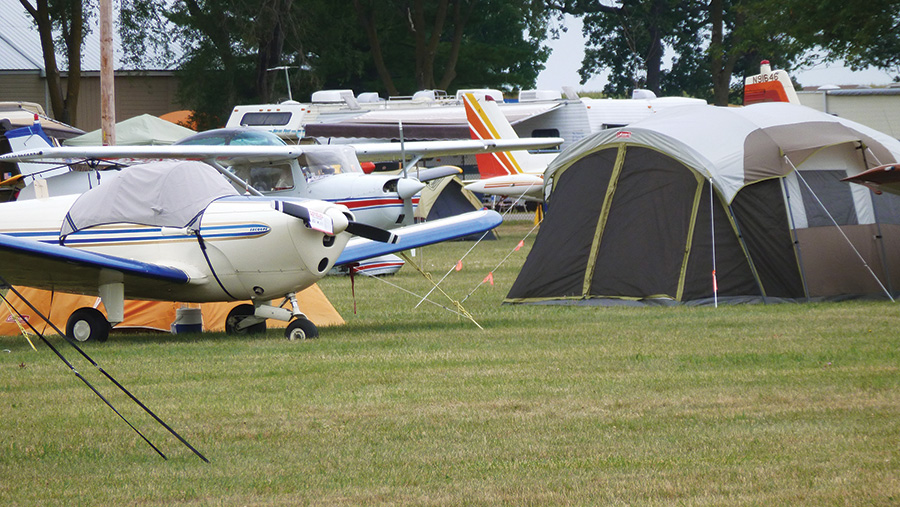
Camping with your airplane at a fly-in event can be a pilot’s Nirvana. Common sense can help the organizers of such events reduce their exposure to liability.
An Expensive Fill-Up
The last example is thankfully not so tragic. At a county airport fly-in, a Lancair IV-P was taxiing around near the fuel island, trying to find a place to park. The nosewheel hit one of the lids that cover the pipes where fuel trucks insert their hoses to replenish the underground fuel tanks. The lid flew up like a quarter will when playing Tiddlywinks and struck the prop, just as the nose wheel sank into the now uncovered hole. While no one was injured, a very expensive engine and prop were trashed in a heartbeat. Naturally, the owner of the Lancair was a bit peeved at the airport since you are supposed to be able to taxi over these lids if they fit properly and seat into the pipe hole that they cover. Again, the airport’s insurance company paid out a handsome sum.
Lessons to be Learned
There are lessons to be learned from each of these instances, but a lot of them boil down to using common sense. If you are the organizer of a fly-in, manage a group such as a local EAA chapter, or an airport that sponsors a fly-in, some simple steps to assure as much safety as possible will go a long way toward eliminating not only physical risk to persons and property, but also to reducing your exposure to liability for any misfortune that may occur.
In our first case involving the T-craft and the unlicensed pilot, while at one time airports may not have used much scrutiny toward operators and aircraft owners, it’s pure folly today to allow such a person and his airplane to operate from an airport. Remember, this guy was based at the airport that got sued; he wasn’t some itinerant over whom the airport had no control. The airport had leased him a hangar for years, yet no one from airport management had any idea of the credentials or history of this character who was their hangar tenant. Any airport that leases storage space, whether it’s in a T hangar, a community hangar, or even open tiedown space should know the pilot and his airplane. Among other terms, leases should require that the airplane be airworthy, assuming that it’s not a homebuilt under construction, and when the lease is renewed every year, airport management ought to look at the airplane’s logs to see if it’s had the required annual or condition inspection. At the same time, the pilot’s certificate and medical, if required for that airplane, should be copied and placed in the file with the lease. It wouldn’t be too much to even copy the log entry for the annual or condition inspection of the airplane and put that in the file. At our FBO, we also copy the pilot’s log page where his most recent flight review is logged, and all of that goes in one file, kept in one place.
I can recall the days when things weren’t so formal. I remember well over 50 years ago when it wasn’t all that uncommon to see student pilots carrying passengers since back then, students weren’t under the watchful eye of a CFI like they are today. Thankfully, those days are fairly well behind us, although these violations do still exist. About 15 years ago, I was involved in a case where a pilot was caught having made over 150 flights with passengers in both a Citation and a Beech Duke, all with only an expired student certificate. The guy could fly OK; he even filed and flew IFR. He just wasn’t blessed with any certificate or ratings to do it legally.
In the second case of the taxiway collision, a little bit of foresight and planning would have prevented that fatality. There was plenty enough blame to go all around. The RV pilot could have anticipated that it wasn’t a real comfortable situation to have a TBM taxiing right behind him, and he could have pulled out of line and let the warbird pass. The warbird pilot could have insisted on having a wing walker beside him to act as the eyes that could see ahead, when the pilot’s could not. The marshals, whose job it was to keep the taxi line safe and properly spaced, could have foreseen that the TBM pilot needed a lot more space ahead of him to see and avoid any obstacles, including not only another airplane, but pedestrians too, and kept him back far enough behind the airplane that he was following to enable him to have that assured clear distance ahead that he lacked.
The last example of the Lancair flipping the lid over the pipe hole could have been prevented if airport line personnel had made sure that, after the fuel truck left and the underground tanks were filled, the cover plate was properly seated. Of course, a two-minute daily inspection probably would have disclosed the problem and, in another minute, the lid could have been placed over the hole and secured.
Anticipating Problems
Safety is not a simple concept, and volumes have been written about aviation safety. Whenever I teach about safety, whether it’s to a flight student in a dual instructional setting, a ground school class, or a talk at a pilot meeting or safety seminar, I stress the importance of getting people to think about what can possibly go wrong with whatever it is they are doing or are about to do. By anticipating the errors that can be made, steps can be taken to eliminate or avoid those risks. Common sense and an analysis of the potential risks involved in any aspect of human endeavor go a long way to making that activity safe.
I never assume that just because a person has a pilot certificate, they will act in a safe manner and use common sense to anticipate the operation of Murphy’s Law. I have represented flight schools and FBO rental operations that have had their customers run into some trouble, be it minor or major, and then the manager of the FBO or school will tell me that because the customer has a pilot certificate, he assumed that the pilot knew better.
If you are an organizer or sponsor of a fly-in, think through just what risks are posed for participants. If airplanes are going to be parked in the grass areas of an airport, walk the area and look for gopher holes, muddy patches, and the host of other hazards that can cause grief to some airplanes. Think about who may attend in what types of aircraft; if you fly a tailwheel airplane, you may not be too concerned about some roughness in a sod area. But if a Mooney, with its scant prop clearance, tries to taxi over a rough grass area that would give you no concern in your own airplane, the Mooney may well have a prop strike.
Assign some knowledgeable people to marshal parking and taxi areas, and don’t assume that pilots will find a safe parking area at a strange airfield. And always remember that pedestrians are a constant problem. Just because someone flew into the event doesn’t mean they are aware of the hazards of being around airplanes. It may be that person’s first airplane ride with a friend who brought them to the fly-in. If a person survives a prop strike accident, which is seldom, it is almost always with horrific and disfiguring injuries. Don’t let people fend for themselves.
I have noticed in the past several years, the bomb drop contest has fairly well disappeared from the fly-in scene, and for good reason. It demands skills that many pilots either lack completely, or which have become rusty. Think about this if flying events are to be included in your fly-in. Spot landing contests are another potential danger area. If the spot landing contest allows participants to use power, and the goal is to plant the wheels on the spot, the risk is fairly minimal. But if your contest is built around reducing power to idle when abeam the threshold on downwind, and then timing the turns in the pattern and the application of flaps or use of a forward slip to modulate a power-off glide angle, be very careful in deciding whether you want such a contest.
Human nature being what it is, all too many pilots will try to stretch a glide, or engage in some dramatic and excessive slipping to lose excess altitude, rather than just going around and abandoning the approach. No one wants to accept failure, especially in front of a crowd of onlookers. But accepting failure and going around sure beats having an accident from landing short of the runway if too low, or running off of the departure end if too high.
Those who organize or direct one-day fly-ins at small airports may not be able to procure liability insurance at any reasonable cost. While there is a principle that almost anything can be insured at some price, that price is most likely prohibitive in this situation. However, the airport itself will almost always have some sort of liability policy in force, and it would be wise to ask to see the airport’s policy. If the organizing group is unsure of the coverages provided in the airport’s policy, take a copy of it to a knowledgeable aviation lawyer and find out what is and isn’t covered. Investigate ways that the fly-in can be held under the aegis of the airport if the airport has the liability coverage in its policy to protect it and the organizers of the fly-in.
Fly-ins are a historical part of general aviation at nearly all levels. They can and should be fun and safe. All it takes is for the organizers and sponsors to think ahead, anticipate what can go wrong, and take overt action to eliminate those risks. See you all at Oshkosh in 2015, and maybe at another fly-in or two.
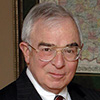
![]()
Jerry Eichenberger is an actively practicing aviation attorney in Columbus, OH since 1975. He is also an FBO owner, commercial pilot rated for single- and multi-engine airplanes, helicopters and gliders, and is a CFII and multi-engine rated flight instructor. This article is not intended, nor should it be considered and relied upon, as legal advice applicable to any specific situation or contract. It is intended for general information only.

